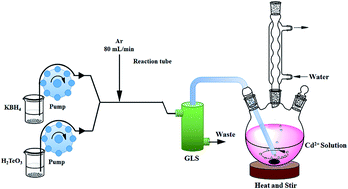Aqueous synthesis of CdTe quantum dots by hydride generation for visual detection of silver on quantum dot immobilized paper
Abstract
A novel visual detection method was developed for silver using CdTe quantum dot (QD) immobilized paper. CdTe QDs were synthesized in aqueous solution by hydride generation (HG) for the first time, with H2Te gas being introduced into the aqueous medium containing Cd2+ ions. The gaseous precursor, H2Te, is generated on-line by reducing TeO32− with KBH4. The visible fluorescence from the CdTe QDs immobilized on paper was quenched by Ag+. A limit of detection (LOD) of 0.01 μg mL−1 and a relative standard deviation (RSD, n = 7) of 2.1% at a concentration of 1 μg mL−1 of Ag+ were obtained when using a commercial fluorescence spectrophotometer as the detector. In visual detection, as low as 1 μg mL−1 of Ag+ in antibacterial textiles and drugs can be easily discriminated from the blank with the naked eye. The proposed method has several unique advantages, including straightforwardness, rapidness, affordability and requirement of no equipment for visual detection.



 Please wait while we load your content...
Please wait while we load your content...